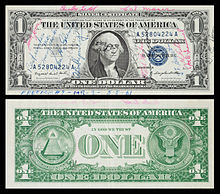|
Short snorter A short snorter is a banknote inscribed by people traveling together on an aircraft. The tradition was started by Alaskan bush flyers in the 1920s and spread through the military and commercial aviation.[1][2] During World War II short snorters were signed by flight crews and conveyed good luck to soldiers crossing the Atlantic.[3] Friends would take the local currency and sign each other's bills creating a "keepsake of your buddy's signatures".[4] The General Hoyt Vandenberg short snorter was started in June 1942 flight over the mid-Atlantic. The Harry Hopkins short snorter was collected on July 25, 1942, by an aide of Franklin D. Roosevelt at a London Conference. The D. Ray Comish short snorter was collected January 1943 at the Casablanca Conference by Dixie Clipper. The Averell Harriman short snorter was collected by him at the January 1943 Casablanca Conference as well. The General George S. Patton snorter signatures were also collected at the Casablanca Conference. The Yalta short snorter signatures were collected on February 4–11, 1945 by Steve Early at Yalta, on the Crimean Peninsula. EtymologyMerriam-Webster defines a short snorter as either "a member of an informal club for which a pilot, crew member, or passenger who has made a transoceanic flight is eligible"; or "a piece of paper money (as a dollar bill) endorsed by short snorters as a membership certificate for a new member."[5] "Snort" is slang for a "mixed drink,"[6] and "short" specifies less than a full measure.[7][8] According to a November 2002 article in The Numismatist, "About 100 years ago, a 'short snort' was a slang expression for less than a full shot of liquor. Pouring short snorts guaranteed barkeepers a little extra profit in each bottle. Also, drinking only a short snort allowed the imbiber to honestly point to his moderation. Years before federal aviation regulations, pilots discovered that alcohol and airplanes do not mix, and fly-boys who drank heavily did not live long. Soon, pilots jokingly were calling each other 'short snorter'."[9] HistoryThe tradition is believed to have been started in August 1925, by Bush pilots in Alaska, United States,[7] spreading through the United States military during World War II. When the short snorter was signed, the collector would have to produce it upon request, if not, they are bound to give the signer a drink.[1][7] Short snorters sell on eBay and at other auction venues. During World War II reunions, short snorters were often compared by veterans. John McGarry, executive director of the Lakeshore Museum Center in Muskegon, Michigan, said that every short snorter is "unique because every soldier's story is different."[10][11] The Short Snorter ProjectIn March 2009, Thomas Sparks founded The Short Snorter Project, an American 501(c)3 tax-exempt nonprofit organized and registered in Washington "for educational purposes" pertaining to short snorters.[12] One aspect of the Project's mission is "to illuminate the Short Snorter and those associated with the tradition and provide a means to educate the general public about these artifacts brought home from the war."[13] Notable short snortersGeneral Hoyt Vandenberg short snorter
Harry Hopkins short snorter
D. Ray Comish short snorters
Averell Harriman short snorter
General George S. Patton short snorter
Yalta short snorter
Other short snorters
It was signed by Franklin Roosevelt and various key advisors.[21] A Fiji 5 shilling note is another example of a short snorter owned by Eleanor Roosevelt and signed by Maj. Robert Arnoldus. This same short snorter was later signed by Col. Ed Whitcomb, another of the first class of celestial navigators, class 40-A, taught by Charlie Lunn of Pan Am airlines in Florida. That first class also included celestial navigator 2Lt Louis Gustav Moslener, Jr, one of the first American casualties of WW-II when the first bombs fell on Hickam Field, 7 Dec 1941.
The actress Marlene Dietrich had a short snorter consisting of 83 pieces of currency signed by more than 1,000 dignitaries including Irving Berlin, Ernest Hemingway, and George S. Patton.[22] This short snorter was sold at auction for $5,200 on November 7, 2017.[23]
The first short snorter in Experimental Aircraft Association (EAA) history was signed by founders Paul Poberezny and Stan Dzik and presented to Robert D. Blacker on February 14, 1958, at St. Rita of Cascia High School in Chicago, in order to commemorate Mr. Blacker's creating the organization's first junior chapter, his co-founding of Project Schoolflight, and his building of both the "Spirit of Cascia" Baby Ace and the EAA Biplane airplanes.[24] Space-flown snortersNumismatic souvenirs have accompanied astronauts on early spaceflights.[25] Mercury astronauts carried small light-weight mementos on their missions, often in the form of US coins or banknotes. On the first sub-orbital flight (Mercury-Redstone 3), Alan Shepard carried with him four one-dollar silver certificates which were subsequently signed by him, other Mercury astronauts, and support staff. John Glenn, piloting the first manned U.S. orbital spaceflight Mercury-Atlas 6, also carried several one-dollar silver certificates. Space-flown numismatic items are also known for early Gemini missions. On the first manned Gemini flight (Gemini 3), Gus Grissom and John Young brought 50 two-dollar bills.[26] References
Sources
External links
|
Portal di Ensiklopedia Dunia

